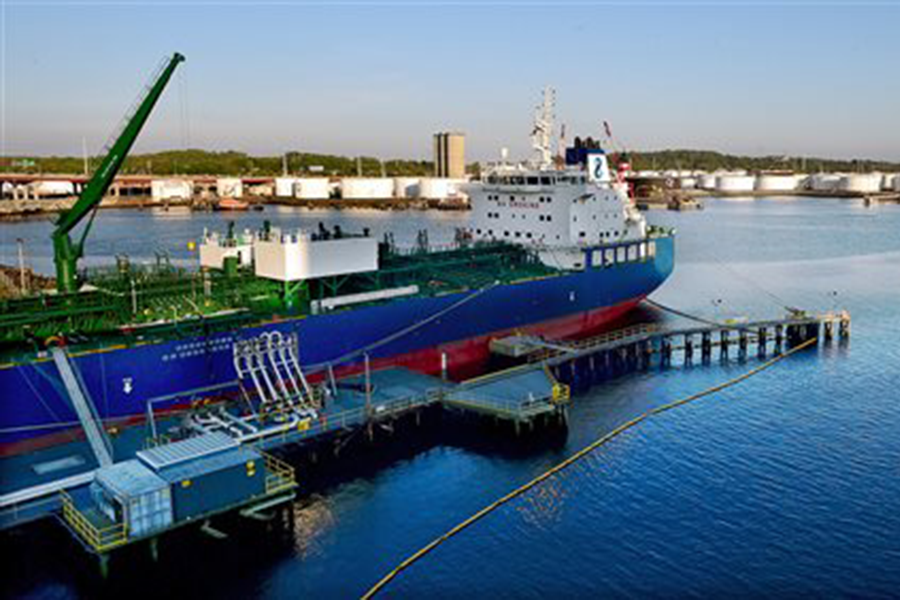New England's ports, long past prime, seek to stage comeback
Loading...
| NEW HAVEN, Conn.
The noise and bustle of nearby neighborhoods fade away at New Haven's sprawling port. An oil and chemical tanker floats placidly at a dock. A tug pushes a barge out in Long Island Sound. Only occasionally do trucks rumble up to a scrap metal business or deliver materials for road work.
What was a key port for lumber and other goods dating to Colonial times is, like other New England ports, facing a reckoning after a lengthy decline.
In the region that nurtured the beginnings of New World commerce with whaling, fishing, and shipbuilding, state and local governments are taking stock of aging infrastructure at deep-water ports. As they move to stake out their share of global trade, the challenge is how to stay relevant in an age of ever-larger ships.
"There are so few people who know about our deep-water ports," said Judith Scheiffele, executive director of the New Haven Port Authority. "I think it's kind of taken for granted."
New England's ports saw their national rankings in terms of total trade plummet since the 1970s, a trend that only accelerated with the Great Recession. New Haven, which ranked 33rd in the nation in 1972 with 13.1 million tons, ranked 57th in 2013 with only 8.4 million tons, according to the American Association of Port Authorities.
The drop owes to issues of access and global forces far outside local control.
Ports constantly need costly dredging, and the will has not always kept up with the need to remove silt. In Bridgeport, Connecticut, New England's southernmost port, ship traffic is severely limited because the harbor has not been dredged since 1964, leaving it short of the standard 35-foot depth in places.
A harbor's depth is key to attracting business and has huge significance for marketing, said Tim Sullivan, deputy commissioner at the state's Department of Economic and Community Development.
Money that once might have gone toward deepening harbors and providing rail and highway connections was used to increase security after the Sept. 11 attacks, according to John Martin, a maritime industry analyst.
Boston is having its harbor deepened to 51 feet at the entrance and 47 feet in inner channels and will be the region's only port accommodating bigger ships, said Edward O'Donnell, chief of the navigation section at the Army Corps of Engineers in New England.
With the exception of Boston and Portland, New England's ports generally handle only cargo that is loaded individually — not the large, more lucrative container shipping.
More commerce is moving on giant ships that can pass through an expanded Panama Canal. New England's location, on the East Coast, doesn't help, either, as lately it is Asia — and not Europe — that sends most cargo by sea to the United States.
A number of governments are puzzling over how to take better advantage of the economic potential at their deep-water ports.
In Connecticut, a state port authority was created to promote three major ports on Long Island Sound: Bridgeport, New Haven, and New London. The goal is to attract investment by marketing them as alternatives to the Northeast's traffic-clogged highways. The state has not made an estimate of how many jobs might be created, an economic development spokesman said.
New Haven is planning a study on whether to dredge down to as much as 42 feet instead of the current 35 feet.
Farther north, the Maine and New Hampshire departments of transportation made it a high priority to create space to accommodate larger ships at the Port of New Hampshire, whatever future vessels might be carrying, when they selected a design for a $173 million upgrade to the bridge over the Piscataqua River separating the two states.
Sixteen companies that use the river and harbor employ nearly 1,000 workers, and the bridge upgrade is seen as preserving those jobs, said Geno Marconi, director of the New Hampshire Port Authority.
Many shipping lines, seeking to maximize profit, invested millions adding large freighters carrying truck-size containers. To capitalize on the investment, ships must deliver at ports that can accommodate their size. Those ports are typically outside New England.
But some in New England see opportunities to capture some of the spillover.
"The much bigger ships from Asia are not likely coming to Connecticut," said Sullivan, of the Connecticut economic development department. "They'll displace smaller ships from larger ports. Those ships are going to need some place to go."
Bridgeport can be a "great secondary market" after the New York-New Jersey port 60 miles away, said Andrew Nunn, the city's chief administrative officer.
Ports also have been seeking out tourists and niches in global trade.
Tourism, embraced by many port cities as commerce began to decline in the early 20th century, has been stressed in deals with cruise ships to promote the cities' maritime history and culture.
And at the Port of Davisville in Rhode Island, about 18,000 cars a month roll off ships, including nearly 850 Bentleys last year. Wind turbine equipment goes to Searsport, Maine, to supply the state's alternative energy products.
Some in the region, like New Hampshire, receive road salt and heating oil, staples for New England winters. Some smaller ports export recyclables such as scrap metals. And from Portland, electric cars are shipped to Iceland, where they are in high demand because plentiful geothermal energy makes them inexpensive to operate.
"We're never going to be Long Beach or Baltimore or Boston," said Bill Needelman, waterfront coordinator for Portland. "We're a niche port that provides services for particular markets and products."
Associated Press writer Michael Sirolly in Philadelphia contributed to this report.





